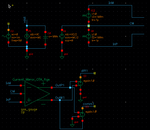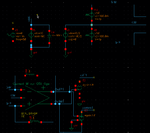Fabien
Full Member level 1
Hi everyone,
I'm trying to size the miller cap for a fully differential OpAmp. Without the miller cap, the phase is around -230° at 0dB (open loop, differential output). I guess, the OpAmp is not stable, but I try to run some simulations and I'm not able to see it oscillating!
Anyway, I'm just wondering what should be the phase margin? 12° or 45°? (it will result in a lower gain, for sure).
Should I check the phase margin for each independant output (+ and -) or for the differential output (Vout+ - Vout-)??
Thank you for your help.
I'm trying to size the miller cap for a fully differential OpAmp. Without the miller cap, the phase is around -230° at 0dB (open loop, differential output). I guess, the OpAmp is not stable, but I try to run some simulations and I'm not able to see it oscillating!
Anyway, I'm just wondering what should be the phase margin? 12° or 45°? (it will result in a lower gain, for sure).
Should I check the phase margin for each independant output (+ and -) or for the differential output (Vout+ - Vout-)??
Thank you for your help.


